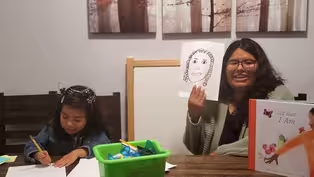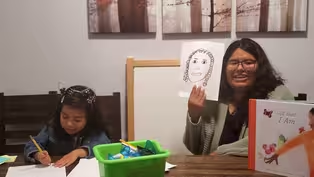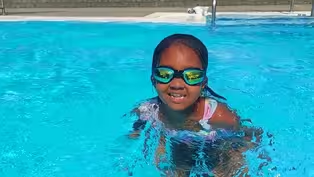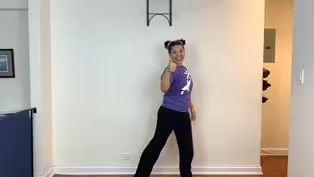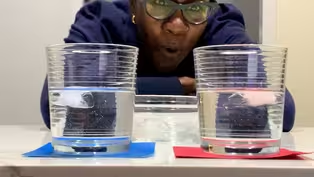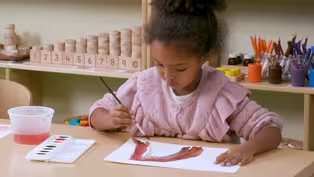
MAKE IT RAIN
Clip: 4/15/2023 | 8m 50sVideo has Closed Captions
Cassondra Easterling simulates the sound rain makes on different surfaces.
Cassondra Easterling and her children make observations about the relative volume of sound water makes when falling like rain on plastic, metal, and cloth. Then she uses a sound meter to determine which surface generates the loudest sound.
Problems playing video? | Closed Captioning Feedback
Problems playing video? | Closed Captioning Feedback
Let's Learn is a local public television program presented by THIRTEEN PBS

MAKE IT RAIN
Clip: 4/15/2023 | 8m 50sVideo has Closed Captions
Cassondra Easterling and her children make observations about the relative volume of sound water makes when falling like rain on plastic, metal, and cloth. Then she uses a sound meter to determine which surface generates the loudest sound.
Problems playing video? | Closed Captioning Feedback
How to Watch Let's Learn
Let's Learn is available to stream on pbs.org and the free PBS App, available on iPhone, Apple TV, Android TV, Android smartphones, Amazon Fire TV, Amazon Fire Tablet, Roku, Samsung Smart TV, and Vizio.
Providing Support for PBS.org
Learn Moreabout PBS online sponsorship[upbeat music] Hi friends, my name is Cassandra and these are my helpers.
- Noor.
- And Emory.
And we're here today to do a fun science experiment with you [indistinct] Noor and Nolan Emroy.
Have you ever paid attention when it rains to the sounds that the rain makes?
- I have, but not often.
- Oh, what about you Emory?
- I have but not that often.
- Oh, what about friends home?
Listen to the sounds the rain makes when it falls on different surfaces.
I sometimes listen to the sounds that the rain makes when it falls on different surfaces and it made me think of an experiment that we could do today.
For this experiment, I have some different materials right here.
I have some plastic.
Noor and Emory, can you think of anything that rain might fall on this made outta plastic?
- Maybe umbrella.
- Maybe an umbrella.
That's a great idea.
What about Noor?
Noor, can you think of something made of plastic?
One thing.
- I think of is [indistinct] - Oh, go ahead.
- A raincoat.
- A raincoat.
So you said an umbrella?
- Yes.
And you said an A raincoat?
- Yes.
- Okay.
Those are great ideas.
An umbrella and a raincoat.
Those are two things that might be made of plastic that the rain might fall off still metal.
One thing that I was thinking of that's made of metal that the rain might fall on is a metal roof.
Have you ever been anywhere before where you there was a metal roof?
How about you Nolan Emery.
Have you ever been where there's a metal roof before?
- Yes, actually I have.
- Yes.
- Yeah.
Okay.
What else might be made of metal that you might hear the rain fall on?
- A car.
- A car.
Rain idea.
- Or a school bus.
- A school bus.
I love those ideas.
That's great.
And then over here we have some cloth.
What might you have that could be made of a cloth that the rain might fall on?
- Clothes.
- Maybe a cloth your clothes.
Of course.
Sometimes when you're outside and you have nothing to protect you, your clothes get the rain.
That's a great idea.
Alright, so for this experiment, we are going to be trying to make some observations.
That's a really big word.
Can you try to say that observation?
Can I hear you?
- Observations.
- So observations.
Can you try to say that friends at home observation - Observations - Observations are what we notice happening when we do a science experiment.
So today we're going to do some observations of what we see happening when we do our experiments.
So over here we're going to put these words, plastic, cloth, and now we're going to put these words over here on our chart a little bit later.
First, we're just going to listen to what the water sounds like when it falls on these different surfaces.
And then we'll use what we've learned to help us to think about what we think might happen in the rest of the experiments.
We're going to try to think which of these materials is the quietest and we'll put that one up at the top.
Which one is the loudest?
We'll put that one at the bottom.
And then we are going to use a sound meter to see if we were priced.
I think this is going to be really cool.
Are you ready for this?
- Yeah.
- Okay.
So let's give this a try.
So Emory, could you just hold this plastic here over the cub for us and we're just going to pour some water on.
This water is going to be our rain for today.
Now we have to be really quiet and listen to what the water sounds like when it falls on this plastic.
Can we do that?
- Yes.
- Okay.
[water trickling] Could you hear that friends at home?
Did you [indistinct] hear that?
- Yes.
- Yes.
- What would you say that one sounded like?
- I think that sound like medium kinda.
- Okay.
What would you say Noor?
- Kinda sounds like not that much, but still kinda sound.
- Okay.
Kinda makes some sound.
Not too much sound, but we could hear it.
So what do you think about the metal?
Do you think the metal will be louder or quieter than the plastic?
What do you think?
- I think it'll be louder.
- You think it'll be louder?
What do you think Noor?
- I actually, I'm gonna make a prediction.
I think it'll be the loudest out of all.
- Oh, you think that one will be the loudest of all?
Okay.
Well let's see.
You ready?
- Yeah.
Noor, could you just hold this up a little bit to our friends at home can see it?
All right, let's listen.
[water trickles] Huh?
What do you think?
- I think that's the loudest.
- You think so?
What do you think Noor?
- I actually think it's not 'cause that made a sound.
No one made like actual noise.
This one was just like [indistinct].
- Wow.
Okay, so now let's try the cloth.
What do you think is going to happen when we pour the water on the cloth, will we hear it?
- No.
- You don't think so?
- I'm gonna hear it.
Do you think friends at home they we'll not hear this one.
Let's try.
Ready?
[water trickling] Could you hear that one?
- You can hear just a little bit.
- Just a little bit.
- Yeah.
- I think this one was, I think the quietest.
- The quietest.
Okay, so let's put our words in order.
Which one do you think is going be the quietest?
- I think.
- I think it's gonna be the loudest.
- Now which one do you think is going to be the loudest?
Based on what we just heard.
Which one will be the loudest?
- The plastic.
- You think the plastic?
- This one makes the metal looks like [indistinct].
- Okay, so let's try to put metal in the middle.
Let's see if we're right.
Alright, so let's do the plastic first.
Emory, can you hold this right here next to the plastic?
Okay.
All right, friends at home.
Watch that meter.
Now Noor, you have to look at the numbers and tell me what it said.
Okay?
[water trickles] What do you think?
What number?
- 67.
- About 67.
Okay, so we're gonna put 67 over here.
Oops, this one.
Okay, now let's go over to the middle.
Hold it right here and Noor check out the numbers.
Let us know what number it says.
Are you ready?
Hold it to our friends at home to see it.
You ready to go?
- Yep.
[water trickles] It was like 51, 53, so I would say like 52.
- 52.
Oh, wow.
So interesting.
- Difference than I between metal and plastic.
- Wow.
Let's try the cloth, are you ready?
- Yes.
[water trickles] Like it's like 41, 42.
- Wow.
41.
Wow.
So was our prediction, right?
- Extremely.
- Wow, how interesting we were, right?
Wow.
Thank you for joining us today, friend.
We hope you maybe could try an experiment like this before time, you could ask trusted at home to help you get some material and some water.
Pour the water on the material and see what happens.
Thank you for joining us today.
Hasta luego.
Video has Audio Description, Closed Captions
Clip: 6/12/2023 | 9m 42s | Katherine Rodriguez reads ALL THAT I AM by M.H. Clark, illustrated by Laura Carlin. (9m 42s)
Video has Closed Captions
Clip: 4/15/2023 | 9m 42s | Katherine Rodriguez reads ALL THAT I AM by M.H. Clark, illustrated by Laura Carlin. (9m 42s)
Video has Closed Captions
Clip: 4/15/2023 | 12m 12s | Anna Scretching-Cole teaches about the diagraphs th and wh. (12m 12s)
Video has Closed Captions
Clip: 4/15/2023 | 48s | Jordyn and Jada go swimming. (48s)
Video has Closed Captions
Clip: 4/15/2023 | 6m 50s | Jessi Colon from National Dance Institute performs a dance inspired by the Nile River. (6m 50s)
Video has Closed Captions
Clip: 4/15/2023 | 6m 19s | Eve Townsend compares the amount of water different containers can hold. (6m 19s)
Video has Closed Captions
Clip: 4/15/2023 | 9m 1s | Lia Zuvilivia from Studio in a School guides students painting with watercolors. (9m 1s)
Providing Support for PBS.org
Learn Moreabout PBS online sponsorshipSupport for PBS provided by:
Let's Learn is a local public television program presented by THIRTEEN PBS
